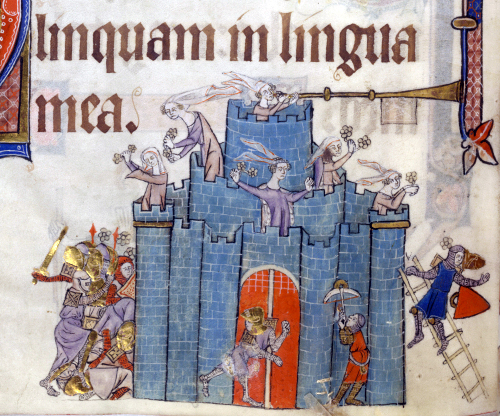ON THIS DAY: 9 April 1216 – A peace treaty was signed, concluding the War of the Castle of Love, fought by Venice, on one side, and Treviso and Padua on the other.
The war began in the most unlikely circumstances – with a courtly pageant. In 1214, Treviso announced a festival called the ‘Court of Solace and Mirth’, which was to be held over eight days, beginning at Easter. Invitations were sent to over 5,000 people from Venice, Vicenza, Verona, Friuli, Feltre, and Belluno. Jousting and dancing were organised, and, as the centrepiece for a courtly pageant, a wooden ‘Castle of Love’ was constructed outside Porta San Tomaso at La Spineta. Ladies and damsels defended the structure while being playfully assaulted with flowers such as lilies and violets, various spices including cinnamon and cloves, and vases filled with rosewater or ambergris. Even pastries, tarts, dates, and apples were thrown.
The decision on the city to which the Castle of Love should surrender was overseen by a panel of knights acting as referees. However, when the Venetians began throwing ducats, the women abandoned their defence of the castle and rushed to pick up the money. Seizing the opportunity, the Venetians attempted to enter the castle, leaving the Paduans furious at the breach of protocol. A brawl broke out, and the rectors of Treviso and the commander of the Paduan militia needed to intervene to break up the conflict and prevent bloodshed.
The pageant was ruined, and tensions between the Paduans and Venetians escalated. Commerce between the cities was banned, and mutual robberies and violence followed. As a result, in the autumn of 1215, Padua invaded Torre delle Bebbe, near the mouth of the River Adige. Venice had built the tower to control traffic on the Adige, and it was garrisoned primarily by men from Chioggia. At high tide on October 22, the guards at the tower launched a counterattack on the Paduan camp, capturing 400 prisoners.
Following the intervention of Patriarch Wolfger of Aquileia, separate peace treaties were signed for Padua and Treviso at San Giorgio in Alga on April 9, 1216. He was likely given a papal commission to broker peace, as Pope Innocent III was preparing for a new crusade and sought stability among the Christian states of Europe.
In the end, no one city was officially blamed. The culprit was, instead, a familiar villain – for the the fine print of the treaty read:
‘On the occasion of the games of Treviso, no small war between Venetians and Paduans arose, instigated by the devil.’

